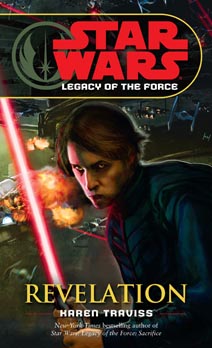With “Revelation” (2008), the eighth book in the nine-book “Legacy of the Force” series, Karen Traviss again delivers a novel that’s so well-written that it overcomes the central flaw of this saga: that it’s unbelievable that Jacen Solo has become Darth Caedus. Writing almost poetically about Mandalorian culture, Traviss nicely meshes the storylines of Boba Fett’s extended family and Jaina Solo’s. Also, she writes a thrilling battle sequence that culminates in the split of the Galactic Alliance into two factions: Jacen’s and Niathal’s.
Admittedly, there are a couple of soft retcons that come to the fore in “Revelation.” The last time we saw Admiral Daala, back in Kevin J. Anderson’s books, she was a power-hungry sociopath on par with Caedus himself. Her military choices in “Champions of the Force” were cartoonish. Now she is portrayed as a principled Imperial and brilliant strategist whom Admiral Pellaeon and Boba Fett both hold in high regard. And she’s also extremely wealthy, able to pay the Mandalorians’ high fee for mercenary work. (To be fair, the question of how a lot of “Star Wars’ ” main characters make their money remains open throughout the EU.)
And while it made sense that Tahiri was under Caedus’ sway because of the lure of flow-walks to see the late Anakin Solo, in “Revelation,” Tahiri now wholly supports Caedus’ mission. There was no indication in past books that she had imperialist leanings.
Daala and Tahiri taking on these traits smacks a bit of “Let’s put familiar characters in these roles,” a strategy that worked out brilliantly with Lumiya earlier in the series but is a bit head-scratching in these cases. On the other hand, there is a certain page-turning quality that results from trying to figure out why Jacen, Tahiri and Daala have changed so much from their past behavior – and the next nine-book series, “Fate of the Jedi,” does indeed examine those questions more in-depth – and indeed, Daala’s power-hungry and imperialist traits return to the fore.
Despite these missteps, Traviss generally shows herself to be the anti-Anderson, someone who analyzes characters’ motives and galactic political reactions to make sure they hold up. Often, she works through these issues in the prose itself. A lesser writer would have ignored the fact that Caedus murdered his underling, Tebut, in the previous book and left readers to say “Well, some people are just above the law – and after all, we saw what happened when Mace Windu tried to arrest Palpatine.”
But Traviss has Admiral Niathal, the Galactic Alliance Guard’s Shevu, Ben Skywalker and others work through the reasons why they have to time their move on Jacen carefully. While a murder case against Jacen would be open and shut if he were a mere civilian (there was a whole bridge full of witnesses), he has indeed built up enough political power to allow him to brazenly break laws. This is also why, when the GA breaks into two factions, Jacen gets to return home to Coruscant (where he has high approval ratings from the public) and Niathal has to set up a government in exile on Fondor.

The Second Battle of Fondor marks the GA’s split, and Traviss gives us a tense moment when Niathal and the Fondorians agree to a surrender and cease fire, but Caedus disregards it. My mind was spinning trying to keep all the allegiances straight: Niathal has Pellaeon as an ally, Pellaeon has Daala as an ally, and Daala has the Mandalorians as an ally. The Fondorians have the Jedi on their side; plus, Niathal also has the Jedi as a secret ally – but in such a way that she won’t be seen as siding with the enemy. Yet the action is suitably tense when Jaina (taking lessons from Fett, and joining him on this mission) nearly crosses paths with her brother.
Another nice touch in the battle comes when Luke projects a Force illusion of an enemy fleet to Jacen. We had seen this tactic used by the magician Xaverri in the “Han Solo Trilogy” and by the Fallanassi in the “Black Fleet Crisis” trilogy (and I feel like it was used in “Tales of the Jedi,” too), but this is the first time we see it from the perspective of the person being tricked.
While some readers might find that Traviss overwrites when examining Mandalorian culture (which she invented almost entirely on her own, right down to Mandalorian language, in the “Republic Commando” series, which continued even after “Revelation” was published), I find her prose in these chapters engagingly poetic, if a bit slow. Finally, in her third book of this saga, Traviss puts a bow on long-simmering mysteries: Gotab, the Force-user who lives in the hills outside Keldabe, is Bardan Jusik; and Fett’s split from his family came about because he was convicted for murdering his wife’s rapist.
Much of the middle ground of Fett’s story went untold in real time in Legends lore, but the arc-bridging revelations here are fairly satisfying. Traviss managed to create a rich backstory for Fett, springboarding from Beau Smith’s short comic “Outbid But Never Outgunned” in “Star Wars Tales” Issue 7, which introduced Fett’s wife, Sintas Vel. (A bit more of this middle-ground story was later unveiled in the comic series “Blood Ties 2: Boba Fett is Dead.”)
At the same time, Fett – 71 years old in this novel — retains the mysterious loner status that made him an icon. Some fans say Traviss’ Fett doesn’t feel like the real Fett, but I wonder if those readers would be satisfied by any story that digs into this character. I think he’s more on point here than in, say, “The Bounty Hunter Wars” trilogy, when he really does talk too much (although I enjoyed those books overall).
The final “LOTF” book is called “Invincible,” but it might as well be called “Inevitable”; even on the first read, it was clear the saga would culminate with Jaina having to confront her fallen brother – in a parallel to Luke confronting his fallen father in “Return of the Jedi” (indeed, the cover art features the twins dueling). The pleasure of the “LOTF” saga isn’t so much about what happens as what characters are thinking about. I like how Beviin teaches Jaina a berserker tactic that will allow her to kill Jacen, but later, Mirta Gev – haunted by the fact that she almost killed her grandfather, Boba Fett, without hearing his side of the story — tells Jaina that she should do anything she can to capture and redeem her brother.
More than any other author, Traviss holds “Star Wars” heroes morally responsible for their choices, but she also sympathizes with them as human beings. Unquestionably, Jaina should kill Jacen, for the good of the galaxy; indeed, she and the Jedi Order should have done so already, and they probably would have if not for the family tie. But just because the answer is easy, it doesn’t mean the action will be.

